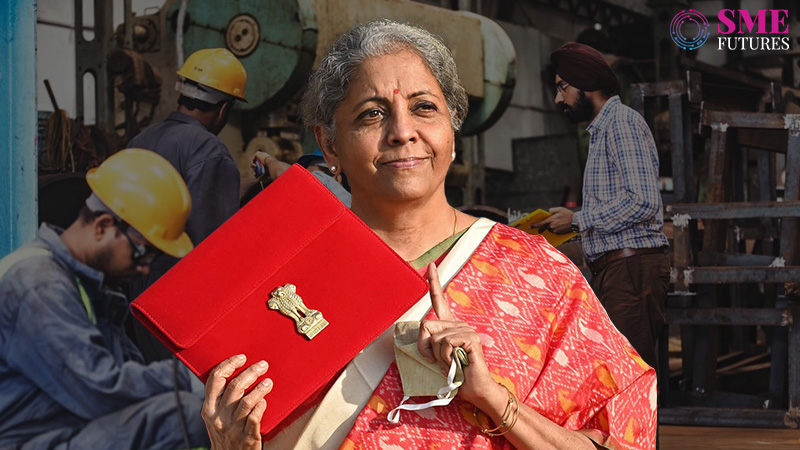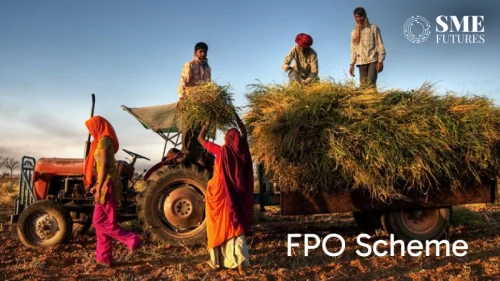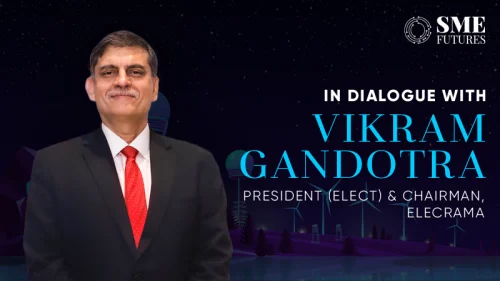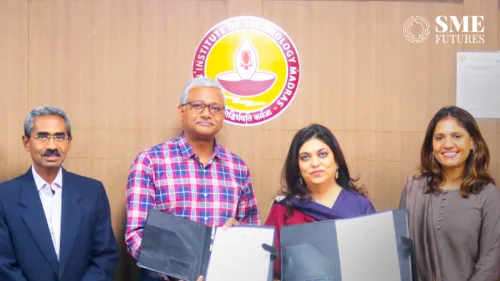Finance Minister Nirmala Sitharaman unveiled a larger Union Budget of Rs 39.45 lakh crores for 2022-23. To boost economic growth and speed up the recovery from the pandemic, the budget prioritised four areas: the PM Gati Shakti Mission, inclusive development, productivity growth, and financial investment. She stated that the budget will serve as a road map for the next 25 years.
“We are marking Azadi ka Amrit Mahotsav, and have entered into Amrit Kaal, the 25-year-long leadup to India@100,” says FM Nirmala Sitharaman.
At the same time, PM Narendra Modi in a tweet declared that this budget would bring in new hope and opportunities.
Major highlights of the budget
India’s growth is estimated to be at 9.27 per cent in the current year, the Finance Minister informed during the budget, adding that it is the highest among all the large economies. While the government had projected the GDP growth to be at 8 to 8.5 per cent.
This year, the Finance Minister has focused on increased spending on building infrastructure in the country. She announced various initiatives around highways and affordable housing. While there is no change in personal income tax slabs or tax rates, there is a clear focus on ramping up the spending on infrastructure to create jobs and boost economic activity. Also, a scheme for design led manufacturing is to be launched for the growth of 5G.
The budget for the fiscal year beginning April 2022 also proposed a massive 35 per cent increase in capital expenditure to Rs 7.5 lakh crores, along with customs duty rationalisation, an extension of time for establishing new manufacturing companies, and plans to launch a digital currency and taxed crypto assets.
As a step to double the farmer’s incomes, the FM announced that over Rs 2.25 lakh crores of MSP will be directly transferred to them. For MSMEs, credit guarantee and many new schemes have been announced.
On the education front, the FM announced the eVidya and digital university programmes to boost the education sector in India. The budget also provided an impetus to mental health with the announcement of the National Tele Mental Health Program. To give a boost to the start-up community, she capped the surcharge on long-term capital gains at 15 per cent. As a push to promote exports, the SEZ Act will be replaced with a new legislation and states will become partners for the development of infrastructure.
As expected, reactions are pouring in on the various budget announcements and it’s a mixed bag of feedback. Largely, India Inc is applauding the budget and are calling it balanced with an inclusive roadmap for growth. On the other hand, there are several analysts who are pointing out what has been left out or has been ignored.
Budget 2022: A roadmap for growth for India@100
Kiran Majumdar Shaw, Executive Chairperson, Biocon & Biocon Biologics has called this budget a balanced budget.
Irfan Razack, Chairman and Managing Director, Prestige Group also finds the Union budget 2022 visionary and ambitious.
“It has allocated a substantial thrust towards infrastructure development, urbanisation, agriculture and digitisation which will help in overall economic growth including in employment generation,” he says.
Razack adds that it’s a relief that the prices of the steel industry and of the import of raw materials remain unchanged. And this will give an impetus to the real estate and ancillary sectors. “This forward-looking outlook has recorded a positive reaction from the market and is likely to aid the upswing in property buying too,” he adds.
Mahesh Palashikar, President at GE-South Asia is happy with the budget as it lays down a blueprint for sustainable development in the future.
“We applaud the government for its consistent commitment and sharp focus on the important priorities of improving climate change and accelerating energy transition. The suggested framework around Gati Shakti (infrastructure development) and inclusive development will lay a good foundation for long-term infrastructure with an eye on short term economic and job growth,” he comments.
“The launch of the sovereign green bonds is an evidence of the government’s active support to ‘Green’ which will significantly help reduce the carbon intensity in the years to come. For India to achieve its climate goals, financing is the need of the hour. This will require deep public-private partnerships,” he adds.
CP Gurnani, MD & CEO, Tech Mahindra touted this budget as a good one. He says that the budget truly echoes India’s vision of inclusive development and of building a truly ‘Atmanirbhar Bharat’.
“Announcements on blockchain and e-passports with futuristic technologies are a step in the right direction to emerge as a global technology leader. The focus on innovation and R&D with an emphasis on strengthening talent capacity through STEM universities and skilling courses in IIT’s will enable us to become a global hub for skilled talent. Overall, Budget 2022 promises to provide the much-needed impetus to sustain India’s economic and digital growth,” he points out.
Anand Srinivasan, MD of Covestro India Pvt Ltd also lauded the FM’s take on clean and sustainable mobility by providing cleantech, special mobility zones with a zero fossil-fuel policy and EV vehicles.
“We all know that plastics integrated electronics, thermally conductive plastics and signal transparency are here to stay as plastic will continue to support organic growth,” he says.
“We have been collaborating with cross-industry players for alternate raw materials, innovative recycling, and joint solution development as a part of our vision to be circular and provide a holistic tool that enables humans to function efficiently. The possible challenge of the availability of a different skilled workforce aligned to the changing landscape of future mobility will be a challenge that industries will have to collectively tackle to usher in this new era of clean and sustainable mobility, which we wholeheartedly support,” Srinivasan avers.
Harkirat Singh, MD of Woodland’s parent company Aero Club also calls this budget well-balanced with a clear focus on investment to stimulate growth and development.
“Calibration of custom duties for critical components in textiles, leather and footwear is bound to further boost the Aatmanirbhar Bharat vision of the Government of India and will certainly lead to value-added manufacturing and the reduction of imports,” he says.
However, we are still awaiting the clear detailing of the same through the policy document to fully understand / anticipate the benefits that are expected out of the announcements. Industries based in India will certainly see a better scope for the ‘Make in India’ program with home manufactured goods and better justification for the growth of Indian industries. This budget will give way to exports from India and is bound to foster a positive environment for all-round growth.
A forward-looking budget for agriculture
While the budget appears to be focused on infrastructure, agriculture has certainly not been overlooked.
Crop diversification and the promotion of domestic oilseed production are two important breakthrough ideas that can have long-term benefits for the sector. The government’s emphasis on agritech, drones, and digital technology indicates that it wants to accelerate the use of technology to benefit the agri sector. Support for SAUs is a significant step with long-term positive consequences.
Commenting on it, Pravesh Sharma, Director at Samunnati Agro says that the budget seems to be incentivising a forward-looking vision for agriculture.
“I appreciate the government’s stance to continue the MSP regime; however, the key would be involving the private sector for building efficiency in MSP procurement. We also expect the government to come up with practical solutions to address the pending demand of the farmers to provide a legal guarantee of MSP,” he says.
He adds that it is great that 2023 has been declared the International Year of Millets, as this crop is currently not considered in the government schemes and it’s producers are largely small and marginal farmers, that too mostly in the rain fed regions.
“It will be important to ensure the growth of integrated value chains so that the benefits of these nutritious crops can flow back to the primary producers. Introducing Kisan drones is a good step to ensure transparency and efficiency in key farm interventions. However, developing a regulatory framework for the ease of the introduction of and the use of drones is equally important. We believe that The NABARD Fund will definitely promote investment in this sector,” he asserts.
A budget for faster recovery
Along with the extension of the ECLGS scheme up to March 2023, the FM announced a host of different measures. Credit support has been provided in the form of the Credit Guarantee Fund Trust for Micro and Small Enterprises (CGTMSE) revamp with a credit of Rs 2 lakh crores for micro and small enterprises.
These initiatives will help financial institutions to mitigate risk and stimulate credit outreach to MSMEs. The government also announced the inter-linking of the Udyam, e-SHRAM, NCS & ASEEM portals and will be providing services such as credit facilitation and engendering entrepreneurial opportunities.
Commenting on the budget, Shachindra Nath, Executive Chairman and MD at U GRO Capital says, “The budget will certainly aid in the MSME sector’s formalisation and growth. The government has time and again shown distinctive support to the country’s MSME sector and encouraged its contribution to the Atmanirbhar Bharat imperative. The outlay of Rs 6,000 crores for programmes to accelerate MSME performance will surely assist in boosting the sector’s resilience and operational efficiency. Overall, the measures announced in the Union Budget 2022-23 will unlock rapid recovery and will promote the holistic growth of the MSME sector.”
Gaurav Chadha, Business Tax Partner at EY India also welcomes the step of extending the time limit for claiming income tax holiday incentives. “Given the extension, the sector will see more eligible start-ups getting incorporated in the upcoming financial year. Further, the capping of the surcharge on long term capital gains on the sale of unlisted equity shares (from a graded surcharge up to 37 per cent to 15 per cent) will reduce the effective long term capital gains tax rate from 28.49 per cent to 23.92 per cent in the hands of investors, founders and founding team members,” he avers.
Where the budget lacks
Analysts at rating agency Moody’s feel that the budget lacks any tangible measures to increase revenue generation.
Even though the capital expenditure plans have gone up significantly, the fiscal deficit estimate suggests that the government is relying too much on strong growth to help drive fiscal consolidation, says the rating agency in a note.
The budget underscores the government’s previous emphasis on capex to sustain near-term recovery from the pandemic, while simultaneously paving the way for a longer-term restructuring of the economy, it further states.
Also, the various spending initiatives are not offset by any significant announcements related to a further increase in revenue generation; rather, the announced revenue-related measures are aimed at other objectives such as fostering start-up innovation, ensuring more equitable treatment for cooperatives and state employees, and promoting tax compliance through simplification, according to Christian de Guzman, Senior Vice-president, Sovereign Risk Group, Moody’s Investors Service.
No scope for the F&B Industry this time
The F&B sector, which has been under the weather since the pandemic began is not pleased with the budget. The stakeholders feel that more relief could have been given to the ailing sector. Sandeep Satpathy, Cofounder at Biggies Burger says that this year’s budget lacks scope for the revival of QSR businesses.
“The industry needed tax reforms allowing GST Inputs for business enthusiasts interested in exploring opportunities to franchise QSR chains. With more and more people getting into the QSR business, QSR chains like Biggies Burger are expanding rapidly. Absence of provisions for availing inputs on GST levied on franchise fees and the procurements that the franchisees are supposed to pay would continue to make franchising a costly affair despite our efforts to make it a more affordable one,” he says.
Getting a loan has become increasingly difficult for the people who want to explore the F&B space as it is hard to get approvals from banks as compared to the asset intensive MSMEs. “Hence we were also expecting a simplification of the MSME Loan Disbursement process. With such a challenging economic environment since the last two years, the MSMEs in the F&B space were expecting more accessible loan options,” he comments.
The F&B industry generates 3 per cent of India’s GDP, underlining its strategic importance. More than 7.3 million people in India rely on the F&B sector for their income. This makes F&B the single-largest employer in the country.
A hit & miss for the education sector
The FM announced that placing a larger emphasis on digital infra is critical for the education system. However, the educationists feel that the announcements for their sector were a hit & a miss.
Dr. Monalisa Bal, Chairperson at KIIT International School says that the budget lacked announcements pertaining to the development of infra.
“While it has addressed and recognised the learning loss that the pandemic has created, the need to develop digital infrastructure was not adequately addressed. The economically disadvantaged students, especially in rural areas have lost essential years of education and the introduction of supplementary teachers was highly necessary. Supplementary education can help bridge the gap to a large extent,” she says.
On the ‘One Class One TV Channel’ increase announcement, Bal feels that it is not enough. It is important that we adapt the education system, the pedagogies, and the assessments according to the changing times. Upskilling is the need of the hour, she points out.
She suggests that the much-needed increase in the budget allotment for the education sector was missed. “Further constructive measures towards digitization and resuming physical classes are needed,” she says.
A missed opportunity to support women
Deepthi Ravula, CEO at WE HUB applauds the overall budget but points out that the government missed out on announcements for women entrepreneurs. According to her, although there is much emphasis on Nari Shakti, an opportunity for supporting inclusion and diversity has been missed in this budget.
“With the pandemic enabling more women to be a part of the work force & take up the challenges of entrepreneurship, the lack of any support in terms of working capital, technology upgradation and providing incentives to those companies, MSMEs and start-ups that have a larger female workforce has not been looked into,” she says.
With the amount of energy and capital that the start-ups have brought in, the path to integration into preferential procurement has not been spelled out either, she adds.
Though the interconnectivity of MSME portals will improve the ease of doing business, Ravula comments that more could have been done in this regard. “With the immense value that the start-up ecosystem has been able to bring over the past year & the creation of 80+ unicorns, Budget 2022 could have had additional perks for the start-ups in the acceleration phase by way of incentives & support to scale in a much more scalable manner including providing additional support to those in the Tier 2 and Tier 3 areas,” she says.
No priority to health and inequality issues
Recently, the World Inequality Report 2022 ranked India among the most unequal countries in the world, due to the increasing poverty of the general population along with the simultaneous rise of an ‘affluent elite’.
Considering this fact, public health expert and Executive Director of the Population Foundation of India, Poonam Muttreja says that while India can be clearly proud of its growth and economic performance, the government could have done much more to bridge the widening gap between the rich and poor in the country.
“While we welcome the mention of the needs of women and young people in the budget speech, it has not translated into adequate budgetary allocations for these groups. This is despite the fact that the differential impact of the pandemic on vulnerable groups such as women was widely reported, including the gender divide in access to technology and the disruption in women’s access to health services,” she says
“The schemes mentioned in the speech, such as Saksham Anganwadi, already exist and have seen almost no increase in their budget over the previous financial year. If we take inflation into account, these budgets have declined,” Muttreja adds.
Public health does not seem to be a priority in the 2022-23 budget. Even the allocations for the National Programme of Mid-Day Meal in schools, now renamed as Pradhan Mantri Poshan Shakti Nirman, declined by 11 per cent from Rs 11,500 crores in 2021-22 to Rs 10,233.75 crores in 2022-23.
The Finance Minister also did not make any announcements around how the ongoing nutrition crisis will be tackled, despite the rising levels of anaemia in the country as indicated by the recently released fifth round of the National Family Health Survey, Muttreja further says.
Last year’s budget signalled the importance of health and well-being by terming it as the first of six pillars. It also focused on strengthening the three key areas in this field, namely the preventive, the curative and that of overall well-being. However, a similar prioritisation of health is missing in this year’s budget, considering that we are in the midst of the third wave of the pandemic.
However, the focus on addressing the MSME’s issues such as access to credit, skilling programmes, the extension of the ECLGS scheme, and a slew of other measures for various industries has shifted India Inc’s overall sentiments towards the positive. Also, let us know how you feel about this budget in the comments.











